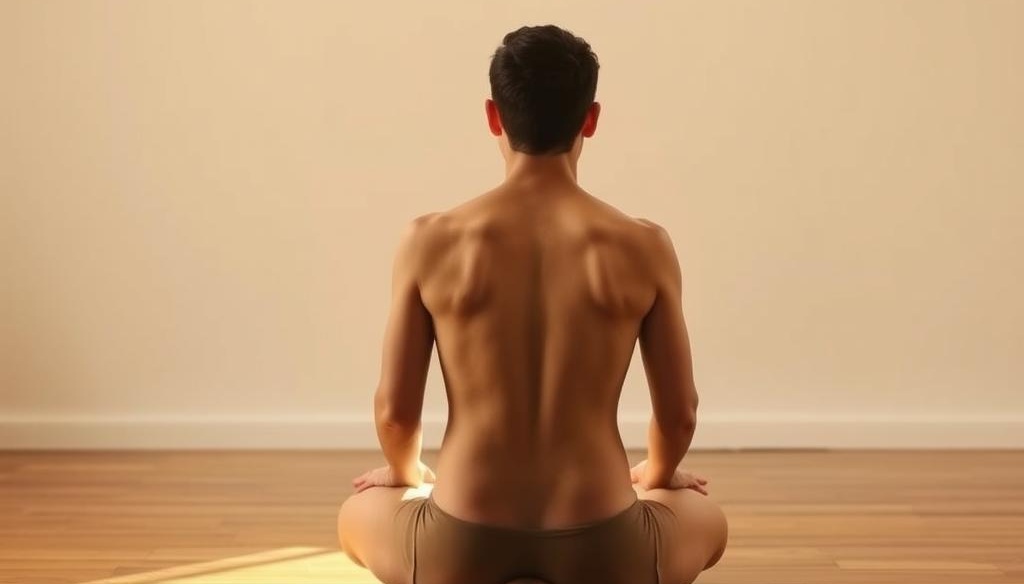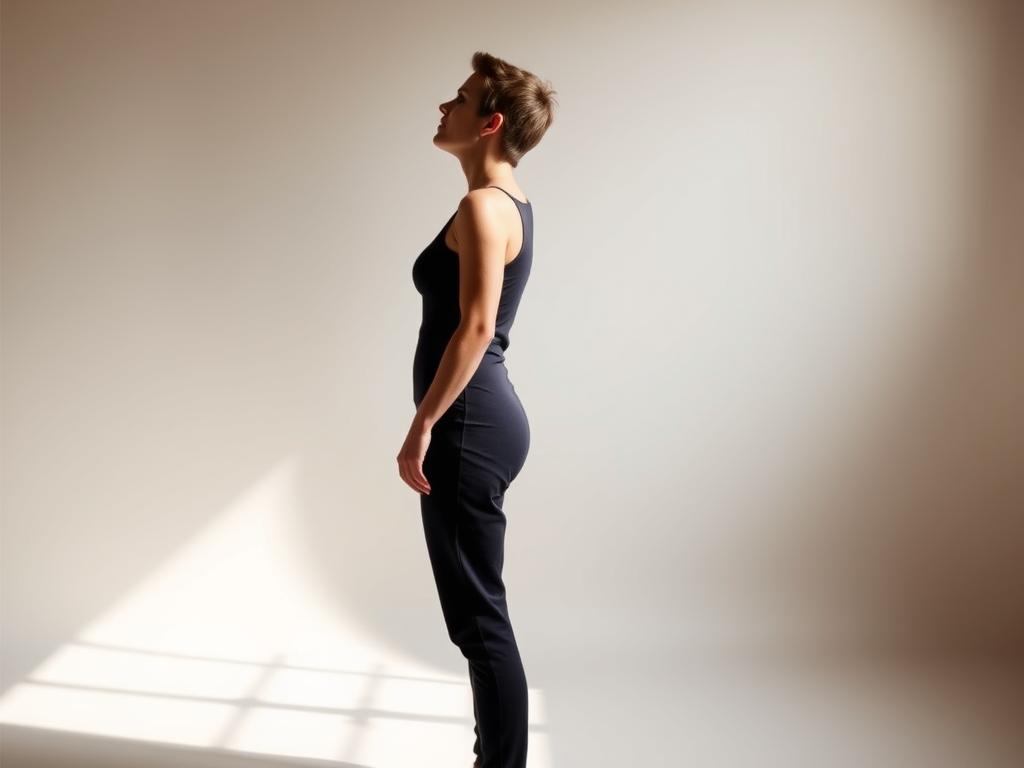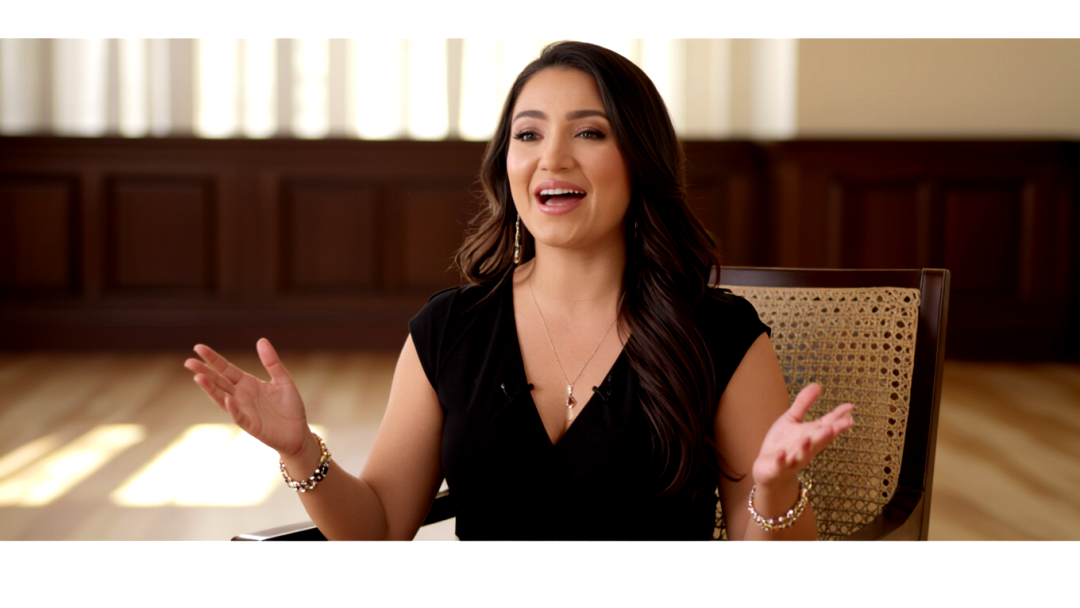Perfect Your Singing Posture for Better Sound
Ever wondered why some singers can project their voice with ease while others struggle? It’s not just about your voice. It’s about how you stand and hold your body. Your body is the base for every sound you make.
When your spine is aligned correctly, your breathing is better. Think of your body as an instrument needing the right setup. How you stand affects airflow, sound, and how long you can sing.
Good singing posture isn’t stiff or uncomfortable. It’s about finding balance. This balance makes your body stable yet flexible. When you find this balance, your singing will get better and last longer.
Your body alignment affects your singing a lot. Many singing problems come from how you stand. By fixing these issues, you can improve your voice.
Key Takeaways
- Proper body alignment forms the foundation for effective vocal technique
- Your spine position directly affects breathing capacity and vocal control
- Good posture balances stability with flexibility for optimal sound production
- Many vocal challenges originate from alignment issues, not technique
- Correct posture reduces strain and helps prevent vocal fatigue
- Alignment improvements can create immediate positive changes in vocal quality
The Critical Connection Between Posture and Vocal Production

Your body’s alignment is key to your singing. It turns your whole body into an instrument. Just like a guitar needs the right setup, your body needs the right alignment for the best sound.
Good posture is more than just standing straight. It involves your muscles, bones, and breathing working together. Bad posture can hurt your singing in ways you might not see.
How Your Body Alignment Affects Sound Quality
Good alignment lets your vocal mechanism work right. Your larynx stays neutral, and your vocal cords vibrate freely. This makes your sound clear and strong.
Bad alignment leads to vocal problems. A Curved spine means your neck muscles are working too hard. This makes it hard to sing freely and limits your range.
Your breathing is affected by your posture. Slouching compresses your lungs. This makes it hard to breathe deeply and can strain your voice.
Your jaw position also matters. A forward head position can cause jaw tension. This can make your voice sound thin and restricted. Good posture keeps your jaw relaxed and your voice open.
The Science Behind Posture and Voice Production
Science shows how it affects your voice. A Misaligned spine means poor breath control. This isn’t good for consistent singing.
Spinal alignment affects your larynx position. Proper spine means your larynx rests correctly. This helps your vocal cords vibrate well without strain.
Posture and breathing are closely linked. Your diaphragm works best when your ribcage is right. Proper alignment lets your diaphragm move freely, expanding your lungs.
Good alignment also helps control air pressure. This is key for a steady tone across your range.
Posture plays a big role in avoiding tension. This leads to better stamina, tone, and less risk of injury.
Knowing these facts helps you see why it limits your singing. Proper alignment is essential for good singing. Misalignment leads to poor sound and health risks.
Understanding the Fundamentals of Posture for Singers - Maintaining Proper Alignment for Better Sound

Getting your posture right for singing means knowing how your whole body helps your voice. When you stand or sit right, your voice sounds better. It’s not just about your throat; it’s about how you move, too.
Many singers forget how important their whole body is. Your body is like an instrument, and how it’s set up affects its sound.
The Alexander Technique teaches singers to keep their spine tall. This is key for good posture, whether standing, sitting, or moving.
The Ideal Singing Posture Framework
Your feet are your base, standing shoulder-width apart. This helps your body stay balanced and supports your posture.
Your knees should be a bit bent. Bent knees help blood flow and keep your body relaxed.
Your pelvis needs to be in the right spot. A neutral pelvis helps your spine and breathing.
Your ribcage affects how you breathe. When it’s aligned right, you can breathe deeper. A bad ribcage position limits your breath.
Shoulders should be relaxed and wide. Tension in the shoulders can hurt your singing. It’s a common problem.
Balancing Stability and Flexibility
Many think good singing posture means being stiff. But it’s about finding a balance. You need support for breathing, but also freedom to move.
This balance lets you move and express feelings. Think of your posture as a flexible framework. When you’re balanced, your singing is better.
Stability comes from your core muscles. They support your spine. This lets your outer muscles stay flexible and open.
Flexibility doesn’t mean losing your posture. It means keeping your core strong while moving. This is key for singing well, even when it’s hard.
The goal is to have “dynamic alignment.” This means your posture supports you, but also lets you express yourself. It’s key for singing well and feeling the music.
Common Posture Problems That Sabotage Your Singing

Many singers focus on breath control and vocal exercises. But they often overlook posture problems.
When your body isn’t aligned right, muscles get tense. This restricts breathing and lowers your vocal range. Let’s look at common issues that harm your singing.
Forward Head Position and Its Effects
Forward head position happens when your head is ahead of your spine. This is common from constantly looking at phones and computers.
Having your head forward makes your neck muscles work hard. This leads to tension in the muscles that control your voice. Your voice box movement and upper range are limited.
When you lift your chin for high notes, it blocks space. Some singers push their tongue back for a deeper sound. This also limits vocal freedom.
To check for forward head, stand against a wall. Your heels, buttocks, and shoulder blades should touch it. If you tilt your chin down a lot, you have forward head posture.
Shoulder Tension Issues
Your shoulders help your lungs expand. Tense, raised, or rounded shoulders limit breathing and cause upper body tension.
Shoulder tension can be chronic or rounded. Both limit deep breathing for singing.
This tension often comes from stress. It becomes your default posture, even when singing. Tight muscles in your shoulders and chest affect your neck and ribcage.
Pelvic Misalignment Challenges
Your pelvis is key to your posture. Misalignment affects your spine and breathing.
Common issues are posterior tilt (tucked under) and anterior tilt (arched). Both prevent core muscle engagement.
A tucked pelvis leads to slouch and restricted breathing. An arched pelvis causes lower back tension and poor diaphragmatic engagement.
Pelvic misalignment also affects your head and shoulders. This can limit your vocal freedom and clear tone.
Fixing these problems can greatly improve your singing. Recognize these issues and make adjustments. Your body is your instrument—align it well for a better sounding voice.
The Alexander Technique: A Singer's Posture Solution

The Alexander Technique helps singers overcome physical limits that block their voice’s full power. It was created by Frederick Matthias Alexander, an actor who lost his voice. He found that changing how he stood greatly improved his voice quality.
Today, it’s a key part of teaching singing worldwide. Many singers say it changed how they sing and stand.
This technique focuses on how our thoughts affect our body. It teaches you to function more efficiently by letting go of muscles that block your voice.
Core Principles for Singers
The Alexander Technique has key principles for singers. “Primary control” is about how your head, neck, and back work together. When they do, your voice sounds much better.
“Inhibition” helps you stop bad habits that hurt your singing. For example, not lifting your chin or tightening your shoulders when singing hard parts.
“Direction” means guiding your body to better alignment with your mind.
“Non-doing” means doing less to get more. Many singers try too hard. The Alexander Technique teaches you to relax and let your voice sing naturally.
Practical Alexander Applications for Vocal Performance
Using the Alexander Technique starts with being aware of your body during singing. A good voice teacher can show you how to fix bad habits. These might be a forward head, a collapsed chest, or tight knees.
Try sitting on the edge of a chair with your feet on the floor. Imagine your top of your head going up while your bottom connects to the chair. This makes your spine long and your neck free, which is key for expressive singing.
For stage performances, the technique helps you stay aligned while moving. It’s great for singing that requires emotional expression through body movements.
Working with a vocal coach who knows the Alexander Technique helps a lot. They can guide you to feel proper alignment, which differs from old habits.
It’s not just about singing better. It also helps you express yourself more in your music. Singers say it lets them connect with their music and audiences better.
By using these principles, you build a strong foundation for your voice. The Alexander Technique is a journey of discovery that keeps improving your singing.
Breath Support: How Proper Alignment Enhances Your Breathing

Proper alignment is key for good breath support. It helps you sing better. When your body is in the right position, you can breathe better and sing stronger.
Your body is like an instrument that needs setup. Bad posture makes breathing hard. Your diaphragm can’t move right, and your breathing suffers.
Poor alignment hurts your breathing. Singers with bad posture breathe shallowly and get tired fast. But good posture allows you to breathe deeply and control your voice better.
Diaphragmatic Engagement Through Alignment
Your diaphragm works best when your spine is straight. It needs room to move down when you breathe in.
Your belly and chest muscles help you breathe better. This makes your voice sound steady.
Try standing right and feel your belly move when you breathe. You will see how much easier it is when in the right position.
Expanding Lung Capacity with Correct Posture
Your lungs need room to expand. Good posture lets your ribcage move freely.
Poor posture limits your breathing. It can cut your lung capacity by a lot.
Your pelvis also affects your breathing. When it’s in the right place, your breathing is better. This helps your core muscles control your breath.
Stand against a wall to check your posture. Make sure your back is straight. Then, practice breathing. You’ll see how much better you can breathe.
Remember, good breathing for singing is not about big breaths. It’s about breathing well. When you’re aligned right, breathing becomes easier. This lets you focus on singing better.
Resonance and Alignment: Creating Your Optimal Vocal Sound

Understanding how your posture affects your vocal tone is key. Many singers focus on technique but forget about the impact of their body alignment. Proper alignment creates the optimal conditions for resonance – that rich, vibrant quality that makes voices carry effortlessly and sound distinctive.
Your body is like an acoustic instrument. Just as a violin’s shape determines its sound, your physical alignment shapes how sound waves travel through your vocal tract. When your body is properly aligned, you create the ideal environment for your voice to resonate fully and beautifully.
How Alignment Affects Your Resonant Spaces
Your body has several key resonating spaces that amplify and color your sound. These include your pharynx (throat), mouth cavity, and nasal passages. The position of your head, neck, and torso directly impacts how effectively these spaces can function.
When your head tilts forward or your chin juts out, you compress your pharyngeal space, restricting a major resonating chamber. This often results in a thin, strained sound, particularly on high notes. Proper vertical alignment of your head allows this space to remain open and flexible.
Your ribcage position dramatically affects your chest resonance. When your chest collapses inward, you limit the vibrations that create warmth in your tone.
Maintaining an open, expanded ribcage allows these vibrations to flourish, creating a fuller, resonant sound without requiring extra effort.
Jaw positioning influences your oral resonance significantly. Many singers unconsciously tighten their jaw or push it forward when reaching for difficult notes. This tension restricts the mouth cavity’s ability to shape and amplify sound. A relaxed, properly aligned jaw allows for optimal oral resonance.
Tension in the face can spread to the throat and restrict resonating spaces. Singers who maintain relaxed facial muscles while keeping proper alignment experience more consistent tone quality throughout their range.
Techniques for Maximizing Resonance Through Posture
To enhance your resonant sound through alignment, start with the “noble posture” exercise. Imagine a string pulling upward from the crown of your head while your shoulders stay relaxed. This creates length in your neck and opens the throat, immediately improving resonance.
Try the “alignment check” technique before difficult passages. Take a quick inventory of your body: Is your head balanced over your spine? Are your shoulders relaxed? Is your sternum comfortably lifted? This brief assessment helps you maintain optimal resonating spaces during challenging vocal moments.
The “resonance mapping” exercise helps you discover your unique optimal alignment. Sing a sustained note on a comfortable vowel while making subtle adjustments to your posture. Notice how small changes in alignment dramatically affect your resonant sound. This builds body awareness that you can apply during performance.
For enhanced high notes, focus on keeping an open chest position. Many singers collapse their upper body when reaching for higher pitches, precisely when they need maximum resonance. Practice keeping your sternum comfortably elevated without tension as you ascend in pitch.
The “flexible alignment” concept is key for dynamic singing. Your posture should not be rigid – it should maintain core alignment principles while allowing for expressive movement. This balance helps you sing with consistent resonance even during emotional or physically demanding performances.
Remember that your best resonance position may differ slightly from other singers. Your unique physical structure means you will need to discover the specific alignment that best serves your voice. Regular practice with awareness of how your posture affects your resonating spaces will help you sing with your most beautiful, authentic tone.
When alignment and resonance work harmoniously, you will experience greater projection, improved tone quality, and more consistent sound production throughout your range. This integration can transform good technique into truly compelling vocal performances.
Standing Posture Techniques for Singers

Your standing posture greatly affects your singing voice. Which means you can breathe better, sound clearer, and sing more smoothly.
Standing right doesn’t mean being stiff. It’s about finding a balance that helps your voice. Your whole body, from feet to head, plays a part in your sound.
Proper Weight Distribution
Start with how you stand on your feet. Try to stand evenly on the balls and heels. This keeps you stable and helps you sing better.
Keep your knees slightly bent. Straight knees can make your voice sound tight. Bent knees let you move freely while staying stable.
Your pelvis should be in a neutral position. This helps your lower back and lets you breathe better. Think of your pelvis as the base of your body.
Try twisting and turning your spine gently. Start at the hips and move up to your head. This helps you feel how your body works together.
Make sure your ribcage is lifted but not stiff. Your chest should be open and wide. Keep your shoulders back and relaxed, avoiding hunching.
Maintaining Alignment During Performance Movement
Singing often means moving, which can be hard. The key is to keep your body aligned while moving.
Practice moving while singing by taking small steps. Keep your core strong. When turning, move your whole body, not just your upper body.
Moving your arms can affect your posture. Practice these movements slowly. Notice how your breathing changes.
Being flexible and aware is key to good posture. Let your breath move freely. Feel grounded and light at the same time.
Good posture balances opposing forces in your body. This keeps you strong and open to your voice. It’s about being grounded and lifted a the same time.
When changing positions, keep your core strong. This keeps your voice steady. Practice these changes often to make them easy.
Mastering these techniques will improve your singing. You will sound better, breathe easier, and sing with more freedom. It will also help prevent vocal strain.
Seated Singing: Achieving Proper Alignment When Sitting

Seated singing has its own set of challenges for keeping the right posture. This is important for your voice, whether you are in a choir or singing with a piano. Without proper posture, your breathing, sound quality, and overall voice can be affected.
When singing while seated, your whole-body alignment is key. The chair can either help or hurt your technique. Unlike standing, where you control your posture, sitting requires adjustments. Learning to align properly while seated helps keep your voice consistent, no matter where you are.
Chair Selection and Positioning
The right chair is the start of good posture when sitting. Choose a firm seat that supports you without being too soft. Avoid chairs that make you lean back too much or sink too low.
Your chair’s height is also important. Your knees should be almost straight, and your feet flat on the floor.
How you sit on the chair is very important. Sit forward, not leaning back, to keep your pelvis in its natural position. This helps your lower back stay curved naturally. When you sit up straight, your lower spine should have a slight curve. Don’t try to straighten too much, as this can cause tension.
To align properly, imagine your spine at a 60-70-degree angle from your sitting position. This angle helps you look straight ahead without being stiff. Place your hands on your thighs to keep your body balanced.
Core Engagement While Seated
Using your core muscles is more important when singing while seated. Without standing support, your abdominal and back muscles must work harder. Think of your core as a flexible column from your bottom to your head.
To engage your core while seated, imagine a string pulling up from your head while your bottom stays on the chair. This stretches your spine without causing tension. Your abdominal muscles should be lightly engaged, supporting you without blocking your breath.
Maintaining proper ribcage position is key for seated singing. Without core support, singers often have less breath. Keep your ribcage open but relaxed, avoiding lifting your shoulders or pushing your chest out. This lets your diaphragm move freely, supporting your voice.
Practice moving between sitting and standing while keeping your alignment. This skill is useful in performances where you might need to change positions. With regular practice, proper seated singing becomes natural. It lets you focus on your art, not on adjusting your body.
Practical Exercises to Improve Your Singing Posture

Changing your singing posture starts with specific exercises. These exercises strengthen key muscles and release tension. Regular practice builds a strong physical foundation, improving your vocal quality and endurance.
These exercises create muscle memory for better breathing and resonance. You will notice improvements in your vocal tone, range, and stamina. Here are some exercises to add to your daily routine.
Daily Alignment Routines
Start each day with alignment awareness for better singing. These quick routines take just minutes but promote proper positioning all day.
The Wall Test is a great baseline check. Stand with your back against a wall, heels touching. Keep the natural curve in your lower back. Hold for 30 seconds, then step away while keeping the alignment.
Balance exercises also help with alignment. Stand on one foot while keeping your posture. This strengthens your core and develops stability for performances. Start with 15 seconds per side and increase your time.
Postural resets are mini-alignment checks throughout the day. Set a timer to remind you hourly to check your posture. Are your shoulders relaxed? Is your head balanced over your spine? Is your weight evenly distributed? These quick checks help you improve your posture consistently.
Strengthening Exercises for Core Support
Your core muscles are key for proper singing alignment. Strong abdominals, back muscles, and pelvic floor support your breath.
The plank exercise is great for singers. Start in a push-up position with forearms on the floor, elbows under shoulders. Keep your body straight, engaging your core. Start with 15-second holds and work up to 60 seconds. This strengthens your core for better singing posture.
Bird-dog movements target deep stabilizing muscles. Start on hands and knees, then extend your right arm forward and left leg backward. Hold for 5 seconds, return to center, and repeat with the opposite limbs. Do 8-10 repetitions per side to improve cross-body stability for performances.
Wall slides are excellent for upper back strength. Stand with your back against a wall, feet slightly forward. Place your arms against the wall in a “goal post” position. Slowly slide your arms up the wall while keeping your lower back, elbows, and wrists in contact with the surface.
These strengthening exercises combat rounded shoulder posture that restricts breathing.
Stretches to Release Vocal Tension
Tension is the enemy of vocal freedom. Regular stretching releases tight muscles that restrict your voice and alignment.
The neck release stretch gently addresses tension. Sit or stand with proper alignment, then slowly tilt your right ear toward your right shoulder. Place your right hand gently on the left side of your head for a slight increase in the stretch. Hold for 20-30 seconds, feeling the release along the left side of your neck. Repeat on the opposite side to promote balanced relaxation.
Chest opening stretches counteract forward posture from daily activities. Stand in a doorway with your forearms resting on either side of the frame, elbows at shoulder height. Gently step forward until you feel a stretch across your chest. Hold for 30 seconds while breathing deeply. This stretch creates space for better resonance and vocal freedom.
Hip flexor stretches address seated posture that tilts your pelvis and affects your alignment. Kneel on your right knee with your left foot planted in front of you. Gently push your hips forward while keeping your torso upright until you feel a stretch in the front of your right hip. Hold for 30 seconds, then switch sides. Loose hip flexors help you sing with better pelvic alignment and deeper breathing.
Incorporate these exercises into your daily routine for cumulative benefits. Start with just 10-15 minutes daily, focusing on areas of tension or weakness. Track your progress by noting improvements in posture and voice.
Remember, consistency is more important than intensity. Regular practice of these targeted exercises that strengthen your postural muscles will gradually transform your singing alignment. This leads to better breath control, enhanced resonance, and improved vocal technique.
Considerations for Different Singing Styles

Every singing style, from classical to contemporary, needs special postural adjustments. Your vocal technique must change for different genres without losing good posture. While keeping your spine straight is key, how you stand, breathe, and resonate changes with each genre.
Classical Singing Alignment
Classical singing needs a formal posture to meet its unique needs. Your body acts as a resonating chamber, needing perfect alignment for sound to project well. Stand with feet shoulder-width apart, with one foot slightly forward for stability.
Your ribcage position is very important in classical singing. Keep your sternum up to manage your breath well in long phrases. This “noble posture” helps keep breath pressure steady for classical vocal tones and prevents collapse in long passages.
Head carriage in classical singing is also key. Hold your head as if it’s being pulled up from above, lengthening your neck. This setup helps your throat and mouth resonate, creating the rich sound of classical singing. Keep your jaw relaxed for clear articulation without hurting your vocals.
Contemporary and Popular Music Adaptations
Contemporary and popular styles often let you relax a bit. But keeping your core engaged is vital. This balance helps you express yourself freely while keeping your voice healthy.
Using a microphone changes your posture in contemporary singing. You must adjust your alignment when leaning towards or away from the mic. Finding the right balance between movement and support is key.
Belt and mix techniques in contemporary styles need specific postures that require strong core support and different head positions than classical singing. Your ribcage must be flexible to handle the wide range of dynamics.
Theatrical Performance Requirements
Theatrical singing is unique because you must align your voice with character movements. You need to be very aware of your body. Work with your vocal coach and movement director to create a physicality that supports your voice.
Performances often have challenging positions that test your alignment. Whether kneeling, lying down, or doing choreography, keep your spine straight. Your voice coach can teach you how to keep your alignment in tough positions while keeping your vocal range open.
It’s important to recover between demanding scenes in theatrical performances. Learn quick resets for offstage moments. These might include gentle stretches, alignment checks, or breath resets to keep your posture right throughout the show.
This focus on alignment helps with both singing and the physical demands of the performance.
Understanding the postural needs of different singing styles helps you adapt while keeping core principles. This flexibility lets you confidently move between genres.
Integrating Proper Alignment into Your Daily Singing Practice
Good alignment is key to better singing. Start by adding a posture check to your warm-up. Before singing, take 30 seconds to scan your body. Make small adjustments for proper alignment.
Use mirrors in your practice space for visual feedback. Recording yourself singing helps spot posture habits you might miss.
Developing body awareness is vital. This sense helps you feel your position without seeing yourself. Try adjusting your posture with your eyes closed, focusing on the feelings in your body.
Body Mapping is a great tool for your singing practice. Your mental image of your body affects your movements. A correct body map leads to better movements and singing.
Create personal alignment cues for your challenges. For example, if you lean forward, remind yourself to keep your neck long. Use these cues until they become second nature.
Remember, singing posture is not about being stiff. Good alignment is the base, but your body should stay flexible. With practice, proper alignment will become your natural state, supporting your singing for years.
FAQ
How does posture affect my singing voice?
It helps your singing by making your vocal mechanism work better. When you stand right, your larynx is in the right spot. This lets your vocal cords vibrate well and your resonating spaces stay open. It also reduces vocal strain. Bad posture, on the other hand, can limit your breathing and cause vocal tension.
What is the ideal posture for singing?
Ideally, a “tall spine” that’s stable yet flexible. Your weight should be evenly spread on your feet. Keep your knees slightly bent and pelvis neutral. Also, lift your ribcage but don’t stiffen it. Relax your shoulders and keep your head balanced. Should feel energized, not stiff.
How can I tell if my posture is negatively affecting my singing?
Signs include vocal fatigue and tension in your neck or jaw. You might find it hard to hit high notes, or it may sound breathy. Running out of breath quickly or having inconsistent sound quality are also signs. If your voice improves when you adjust your posture, it’s a clear sign.
Can I improve my singing just by fixing my posture?
Yes! Many vocal issues, like breath support and range, are linked to alignment. Correcting your posture removes barriers to better vocal function. This creates a base for other technical skills to grow. Many singers see big improvements in sound and stamina just by adjusting their alignment.
What is the Alexander Technique, and how does it help?
The Alexander Technique helps singers by improving body use and awareness. It focuses on the head, neck, and back relationship. It teaches you to release tension and find optimal alignment. For singers, it provides advice to maintain alignment and prevent tension. It emphasizes “non-doing” to reduce excess tension in singing.
How does proper alignment improve my breath support?
It helps your breathing by letting your diaphragm move freely. It also expands your ribcage and engages your abdominal muscles. This setup increases your breath capacity and stamina. It makes breathing more efficient during long phrases.
Can posture really affect my vocal resonance?
Yes, it affects your resonance by shaping your body’s sound-amplifying spaces. Proper head balance keeps your throat open and flexible. When your ribcage is lifted, your chest helps with resonance. A relaxed jaw shapes sound well. These factors impact your sound quality and consistency.
What’s the difference between good posture for standing versus seated singing?
Standing and seated singing have similar core principles but differ in foundation. Standing uses your feet and legs for support. Seated singing relies on your sitting bones and core. Both positions require a tall spine and open chest. The main difference is how you establish your base.
What exercises can help me improve my singing posture?
Exercises like wall alignment and balance exercises are effective. Postural resets and core strengthening also help. Gentle stretches for tight areas are important. The best approach combines awareness, strengthening, and stretching. This helps you maintain good alignment and release tension.
Do different singing styles require different posture approaches?
While core alignment is the same, each style has its own needs. Classical singing needs a formal stance for projection. Contemporary styles allow for more relaxed alignment. Theatrical performance requires maintaining alignment in challenging positions. Adapting to these style-specific needs helps you perform well without compromising your voice.
How long will it take to improve my posture for singing?
You’ll see immediate improvements in your sound with these changes. Developing consistent good posture can take 3-6 months of practice. Changing your body’s patterns takes time and patience. Daily practice and exercises will help you develop lasting improvements in your singing.
Can poor posture cause vocal damage?
Yes, poor posture can lead to vocal damage. It causes tension in your vocal mechanism, leading to fatigue and strain. This can result in serious issues like nodules or muscle tension dysphonia. It can also restrict breathing, causing singers to strain. Proper alignment reduces tension and supports healthy vocal production, preventing injury.
How can I maintain good posture while expressing emotion in my singing?
Focus on maintaining your core alignment while expressing emotions. Start with basic alignment and then add movement. Use your breath as a guide. If a movement affects your breath, it’s likely disrupting your alignment. With practice, you’ll learn to maintain alignment while expressing emotions.
Improve your Singing in 30 Days

Join Our Singing Community
Become a part of the Singing Community and gain access to exclusive resources and expert guidance on vocal techniques. Whether you’re a beginner or a seasoned performer, our community offers support and inspiration to help you reach your vocal potential.

